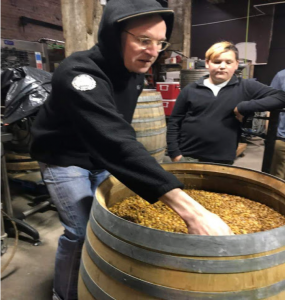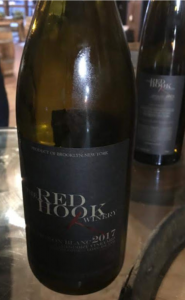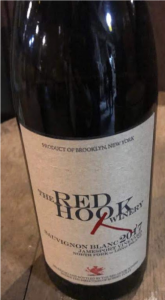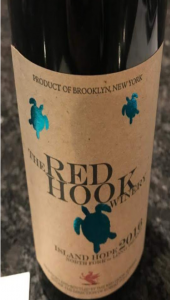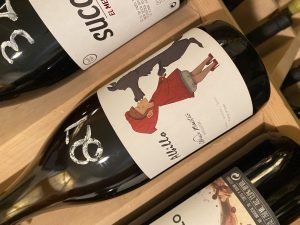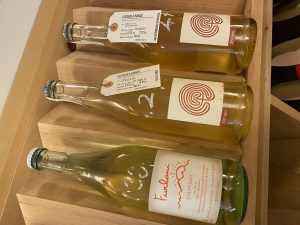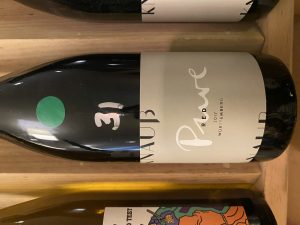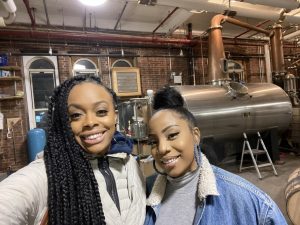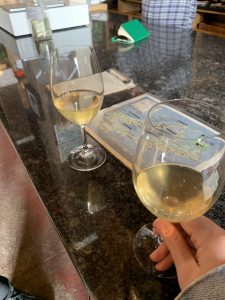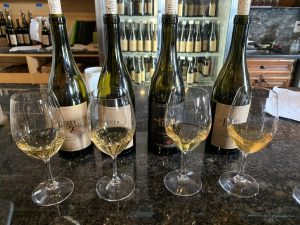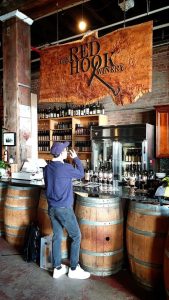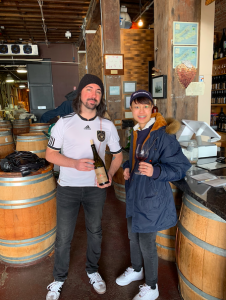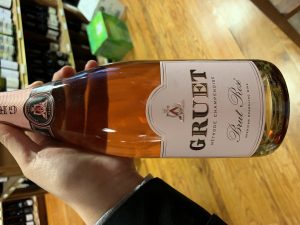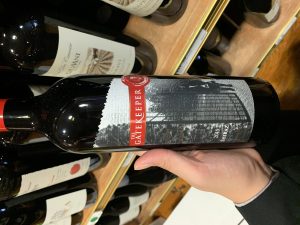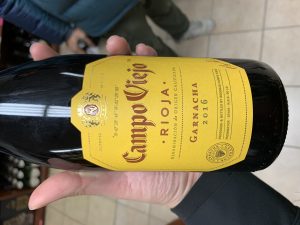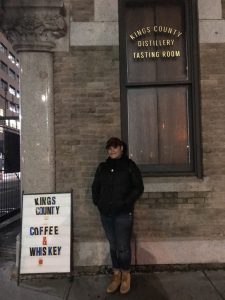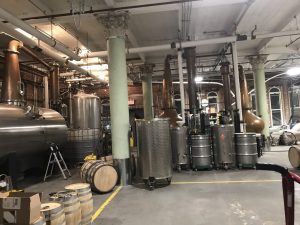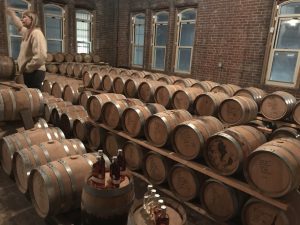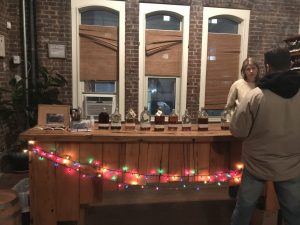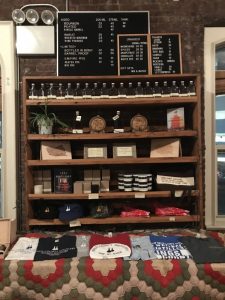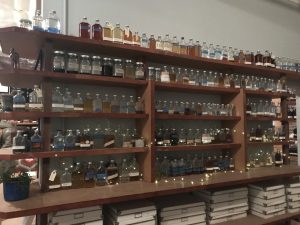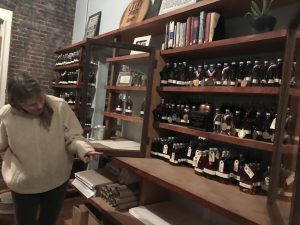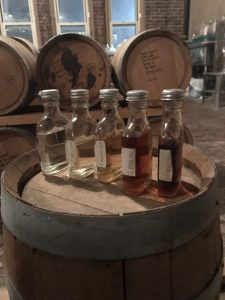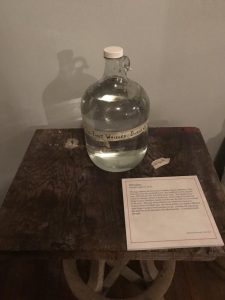Georges_de_Latour_and_Andre_Tchelistcheff
Monthly Archives: December 2019
Cintya Jiménez -My visit to The Red Hook Winery
Image
When making an appointment, you wonder if the person on the other side of the phone is going to be friendly or not. But I ventured forward anyway and the Winery I visited was called “The Red Hook Winery” located in Brooklyn. A person named Ethan answered the phone at The Red Hook Winery, he is a sales representative who sounded very friendly and joyful on the phone. It made me feel great about the idea of choosing Red Hook Winery for my assignment. At first, I was nervous about making a trip to the Red Hook Winery by using the bus, especially making a trip on a bus of that distance from City Tech. I felt the same way about how I was going to get to my destination as well. Once I got to the winery, I got confused about where the entrance was located but enjoyed the beautiful landscapes overlooking the ocean and the Statue of Liberty. Later, I found out it was the back of the winery. Ethan came to my rescue and guide me to their small lounge. He offered me water or wine, which I honestly didn’t want wine on an empty stomach.
The Red Hook Winery’s goal is to represent New York State for people to understand the concept of winemaking. Ethan also mention to guests to feel free to dump the wine on the floor, that they will not be offend by it. He and the staff at the winery want to let visitors express the way that they feel about what they are tasting or what it looks like in their glass. I notice that he kept his word by literally dumping some of his red wine on the floor while he was giving a tour. Some of the grapes were under maceration a process of the grapes being separated from the skin and their juice also called maceration-barrel. There were exposed grapes everywhere in the winery, which explain the fruit flies everywhere. We walked to a wood barrel that had tons of grapes, so we were fortunate to get a first pick at fresh grapes. The winemaker Christopher told us that he protects the grapes from the flies by covering it with a clear plastic bag and spraying some chemicals. It’s also their technique of macerating their grapes.
The pH of wine and alcohol are present all the time when he gets to mix the grapes and its juices inside the barrel. Maceration is the process where the phenolic materials of the grape tannin, coloring agents and flavor compounds are leached from the grape skins, seeds and stems into the must. The next step in macurating (sleeping). He also mentions that maceration is becoming a trend for companies who crafts their own beers. A group of servers from a restaurant in Greenpoint joined us for the tour and they taste the juice from the barrel. Christopher passed around a glass for everyone to taste and tossed it back inside a barrel. I was a little concerned about contamination after everyone who tried the juice from the same wineglass. Christopher explained that the acid was to low and the alcohol was too high for contamination to occur. The extended maceration the Malolative fermentation that often happens during the process. Which the winery doesn’t have the equipment to measure it or if he wanted to bottle that batch wine earl. He would have to send it to a fancy lab in California. To do a Melolactive fermentation.
We got to taste it and it had a strong and bitter flavor from the raw grape juice that made me cough and the skin was hard and not easy to swallow. Making it more common in the production of varietals with less natural flavor and body structure like Sauvignon blanc and Semillon. They used protective spray all over the covered grapes, because they are natural fermentations and can’t protect himself from carbon dioxide while they ferment. They generate carbon dioxide to protect themselves from oxidation and also from critters. In Europe, there is a perception at Finger Lake of growing fruits and not necessarily the wine created in the winery.
Learning about the methods Christopher makes his wine in The Red Hook Winery is very interesting, especially when you get to try out their product straight from the source.I would definitely recommend this place to anyone who is interested in wines to visit during the spring or summer. Also, to enjoy their great outdoor view with their significant other or friends.
The picture on the right shows the front of The Red Hook Winery. The next picture on the left shows how the barriers are situated around the Winery.
Christopher is the winemaker at The Red Hook Winery.The first image above shows the grapes are in the barrier, while the juices are being release under the surface. In the last image he covers the grapes with clear plastic bags to protect it from flies and help control the fermentation process.
Behind me is the stainless steel that can hold two hundred to two hundred fifty gallons. The second image is of a stainless steel wine grape press machine.
The first wine I tried was The Red Hook Winery Sauvignon Blanc 2017 (White Wine). Second wine was The Red Hook Winery Sauvignon Blanc, 2017 from Jamesport Vineyard, North Fork of Long Island (Red wine). Third wine was The Red HookWinery Merlot 2015 Magart Vineyard, North Fork of Long Island.
The fourth wine I tasted was The Red HookWinery – Late Harvest Riesling 2015. I had to purchase this for the holidays from The Red HookWinery Island Hope, 2016. It’s considered a dessert wine. This is an extremely sweet wine. Ethan mentioned this wine will last me at least two weeks. No, need for a dessert.
It cost $45 after tax. If anyone wants to give this wine as a gift to a friend or family member that loves dessert this makes it a perfect gift for the holidays.
This is how the inside of a white and red wine barriers looks like.
I hope you enjoy my post, can’t wait to read yours!! please comment.
Work Citation
Squarespace. “The Red Hook Winery.” The Red Hook Winery, www.redhookwinery.com/.
IPA, Beer
I am often asked “What is your favorite wine?”. I can’t answer that question. There is a lot to consider, food, season, mood, cost…and on and on. Beer, however, I do have one favorite it is IPA. I like the bitterness and feel it does with most foods, it transcends season and mood and cost, well, that fluctuates but, oh well, sometimes I will spend the extra dollar.
Thirst Wine Merchants
For my retail shop visit, I went to Thirst Wine Merchants on Green Ave in Brooklyn, New York. The place is under a little area so it is not noticeable if you are not paying attention. While entering the shop there is nothing exciting or eye-catching about it. The shop gets straight to the point by only having the wine and county it is from. There are little paintings around. This store looked like a place you go to just pick up a bottle of wine you already knew and then going home. The set up of the store was plain.
A pro to this retail shop was the willingness of the worker that was present. He was the only person working in the shop at the time of my arrival. I explained to him what I was doing and he already had an idea because he stated a few of my classmates had come by there already. I asked for all the things I needed and he was able to help in the best way he could.
While asking about the shelf talker, there was no luck because they did not do those at that location. If you were not a worker in the store or someone who knew what wine they preferred or studied then it would be very hard to maneuver around this shop. The only labeling was the numbers on the bottles, the name or the bottle, and the country above it to distinguish between the wines. The stands the wines were put in hard no writing. In my opinion, when you go into a place like that you would expect writing on the shelf. The first place you are looking is down by the wine not above your head, which is where the countries were.
Austria is a country located in Central Europe. Most of the wines coming from this country are from white grape varieties.
At the end of my self-tour, the worker was polite and asked if I needed any more help or had any more questions.
Reference: Austriawine.com
A Visit to Kings County Distillery
For my Visit assignment, I decided to go to a distillery. The distillery I visit is The King’s County Distillery. It is located in Brooklyn, NY in the Brooklyn Navy Yard. It is New York’s oldest, largest, and premier whiskey distillery. This place was founded in 2010. It is known for its handmade moonshine, bourbon, and other whiskeys. The grain used to make their product is corn from the New York area. They use traditional and old distilling techniques along with traditional equipment to make their unique products. They have won awards like the “Distillery of the year 2016.”
The products that come from this facility are mashed, fermented, distilled, and aged in their location then sound onsite in their waiting bar area. This facility used pot stills for their production.
The mashing process done in this machine is not that of mashing like potatoes but extracting the juices and sugar from the corn.
The fermentation process for this is done in large wooden barrels or crates. The yeast is poured on top of the juices and then after the yeast is poured on it is automatically a spirit. It just has to continue to ferment until that process is over.

Charred oak barrels for aging the whiskey. The barrels are made from English wood and only new barrels are used for aging
The second distillation process help takes off this blue substance that is left in the liquor after it is mashed and goes through the first distillation process. This is also when some of the congeners were removed.
The oak barrels along with aging help give the product its distinct color and enhances the aromas.
From this facility, the product is 80% corn and 20% English barley. It goes through a 2 step distillation then aged in new charred oak barrels, never used barrels. New barrels are used over old barrels to prevent the flavors of old products interfering with the brand new product. The aromas and taste of the products are strong with rich caramel, spices of the holidays, vanilla, and the oak of the barrel. Some have hints of corn.
During the end of the tour, we were given a variety of whiskey to taste. We first started with a clear product of whiskey before it is put into barrels to age. This meant there were no flavors to it but the corn it was mashed from. The two year and four-year options had a different taste as in more of the oak-like and caramel feel. We were also given chocolate whiskey which tasted like a rich dark chocolate bar. Along with a holiday spice smelling whiskey that tasted like nutmeg and cinnamon. None of them was my favorite because I guess I am not a fan of whiskey.
The Red Hook Winery
We have a hidden gem in Brooklyn. The Red Hook Winery is where I visited for my winery project. It was founded in 2008 by Mark Snyder. There are three winemakers, Christopher Nicolson, Robert Foley, and Abe Schoener. All three of them create different types of wine. The winemakers have their own stamp on bottles as their signature.
I went with Anna on a Wednesday afternoon. We learned so much information in only 1.5 hours. We learned that the grapes are all purchased in New York State, like near the Finger Lakes. The North Fork of Long Island is also very popular.
Once we walked in, we got greeted and given a glass of white wine. We were examining a map of Long Island where they import some of their grapes. After asking a few questions about the origin of Red Hook Winery, we were going to start the barrel tour. We brought our glasses inside with us to taste straight out of the barrels. After entering through those black doors, we saw where the magic happens.
There were so many barrels, machinery, bottling machine, and a storage room full of fermenting wines. Each barrel had masking tape marked with what type of grape, year, and who was the winemaker. We got to see a giant bladder press out some orange wine. As we go more deep inside, we learned that employees would crush grapes manually, like those old ladies back them. We all think it’s fun and cool, but Collin disagrees. He stated that it was cold and uncomfortable, but the job needs to be done.
We got the try 3-5 days fermenting grapes. It was crazy how there was carbon dioxide, and we felt the bubbling tingly sensation on our tongues. Then, we walked into the 2nd fermentation barrel room. Our tour guide opened 3 barrels to let us try! This was such a cool experience. We tasted all reds: 2016, 2017 Cabernet Sauvignon and a 2017 Merlot. They tasted so smooth, and the oak aromas were very present.
After seeing all the barrels, we went back out to the tasting room. That’s where we tasted 4 reds and 4 whites. We tried a 2013 Chardonnay, 2017 “Storm Master”, 2014 Chardonnay, and 2016 Gefion. All these white wines were from Long Island and made by different winemakers. We tasted all the fresh crisp flavors, some coconut, vanilla, caramel, and even apricot fruits. For the Reds, we had a 2015 Merlot, 2017 Cabernet Franc, 2017 Syrah, and 2012 “League of the Storm”. The Cabernet Franc is from the Finger Lakes and everything else was from Long Island. Reds had more of a smokey, oaky flavor, with green olives, red juicy fruits, and they were all medium to full body.
It was such an honor to visit The Red Hook Winery. It was amazing to see all the behind the scenes, and we got to meet Christopher! My mission would be going to an actual vineyard in Long Island or Upstate in the future.
Citations:
The Red Hook Winery, Wine Region, https://www.redhookwinery.com/about.
Winery visit assignment
The winery that I will be talking about in this paper is Red Hook Winery in Brooklyn. I went there on the 14th of November around the afternoon. It was my first time experiencing winery and see the things that I’ve been studying in class. It was a fantastic tour of Red Hook Winery, and I enjoyed their wines. When I first entered the winery, I got a greeting from the staff and a welcome drink to start. The very first wine I had is Sauvignon Blanc (2016), from Marcari vineyard, North Fork of Long Island. It was terrific, and I loved it. It was not too dry, light, and aromatic to me. The staff mentioned that this wine has produced and bottled under the direction of Robert Foley as we know that Foley is the famous guy from Napa Valley, California, that creating an unusual and expensive wine. We got to talk a little bit about the grapes that they use to produce the wines and places that they purchase the grapes. Red Hook Winery seems to carry many grapes from the vineyard of North Fork of Long Island, then Finger Lakes. I asked the staff about the American viticultural area, but he seemed not to know much about it. He just mentioned that it is an officially recognized wine region in the USA, and all the grapes they have are from the AVA’s areas.
According to Red Hook Winery, “The North Fork of Long Island is dominated by the sea, in every sense. The growing region situated on a narrow “fork” of sea-level land that is sandwiched between the Great Peconic Bay on one side and by the full Peconic Sound on the other. Geologically, the North Fork is a glacial moraine and is composed almost entirely of well-drained sandy loam. Winters on the North Fork are cold but moderated by the surrounding water. Summers, on the other hand, can be hot and exceedingly humid. Humidity, rather than heat or cold, is the most significant challenge posed to winegrowers on the North Fork of Long Island.”
Additional, “The Finger Lakes are characterized by both the lakes for which the region is named and the cold weather that governs the region in winter. The region is situated in west-central New York; the first successful planting of European grape varietals was in 1959 by a Ukrainian botanist named Konstantin Frank. Viticulture is gathered around the steep edges of the four largest lakes. The water moderates the bitter winters and in the autumn helps capture warmth to extend the ripening season. Geologically, the Finger Lakes are dominated by highly fossiliferous sedimentary rock. Glaciation has created a dramatic up churning (& depositing) of diverse rock formations and has left impressively diverse soils in its wake. Racy acidity and keenly defined edges are characteristic of wines grown on the Finger Lakes.”
The tour began after we finished the drink. We walked inside the winery to explore the vitrification, and the first thing I saw was the big machines, many oak tanks, and the tons of dry grapes. The moment we entered the winery, there was a guy who’s cleaning up the machine. He was just finished pressing the grapes, and he let me touch the dry grapes that left out. Also, he opened the big oak tank to show the way they do the maceration. Then, he began talking about the steps of making the wine. We now entered the oak aging area or fermentation room, it was a big room filled with the oak tanks that imported from France. On each tank, there is a tape that has the name of a person who produces the wine, the region, the grape variety, and the vintage year on it. We tasted three wines that haven’t finished on the process of fermentation. The first thing that I noticed is the color of the wine is not normal; it’s light and muddy, which means it is not ready to be served. Second, the taste is strange and a little weird. And the last is I don’t smell any aroma of the wine, and it has only a little bit.
Before the tour comes to an end, we got to taste eight more wines. There were four white and four red. The first white was Sauvignon Blanc (2016), from Marcari vineyard, North Fork of Long Island. The second white was Chardonnay (2012), from Gristina vineyard, North Fork of Long Island. The third white was Chardonnay Reserve (2012), from Mattebella vineyard, North Fork of Long Island. The fourth white was Sauvignon Blanc Reserve, or they called orange wine (2013), from Jamesport vineyard, North Fork of Long Island. The first red wine was Pebbles on the Shore (2013). It is a combination of Cabernet Franc and Merlot. It’s from Jamesport vineyard, North Fork of Long Island. The second red was Merlot (2015), from Macari vineyard, North Fork of Long Island. The third red was Petit Verdot (2014), from Rielly, North Fork of Long Island. This wine, Petit Verdot, is the only wine made from 100% of Petit Verdot. The last red wine was Cabernet Sauvignon (2014), Macari vineyard, North Fork of Long Island.
Most of the wines smell, taste, and look familiar, but the one that I get the most excited about is the orange wine or sauvignon blanc reserve. The sight part, the color is deep golden yellow because it’s darker than Chardonnay and regular Sauvignon Blanc. The wine is clear, I can see through it. The aroma is quite softer than usual Sauvignon Blanc. It smells clean, fresh, and orange aroma. The fruits that I am getting on my nose are jackfruits, green apple, orange skin, and a little bit of hazelnut. The intensity of the wine would be medium-high, and there’s no evidence of gas, no spice, and no flowers. On the palate, it is a dry, sour wine and has a tannin like red wine. I would love to pair this wine with Thai curry dishes at home, and the price of this wine is $60. It is a little high, but it’s worth it. I even got it one for myself.
The experience of visiting the winery is impressive. I can see many things that we’ve been studying in class in reality, and I also understand what they are talking about during the tour about wine production. I never thought that I would love and pay this much attention to wines, but it is a good thing that I know now, and I can explain to my friends about wine stuff. However, this class might be over, but I will continue to study wine and enjoy drinking it forever.

The guy showed the maceration process. He stirs the wine and the grape together to let them mixed well.

My experience of tasting eight wines. Four whites and four reds. Started from the left to the right, Sauvignon Blanc (2016), Chardonnay (2012), Chardonnay Reserve (2012), Sauvignon Blanc Reserve, Pebbles on the Shore (2013) (a combination of Cabernet Franc and Merlot), Merlot (2015), Petit Verdot (2014), Cabernet Sauvignon (2014).
Reference
The Red Hook Winery, Wine Region,
https://www.redhookwinery.com
Farm Brewery Law
NY making strides toward supporting local agriculture and brewing. Have you tasted any of the beers from the breweries listed? Tell us about them.
Heights Chateau
I went to Heights Chateau located not too far from the school. I thought highly of this retail store because it was offered on the wine list that Professor Goodlad provided. Unfortunately, I did not have a pleasant experience. Once I entered with my friend into the store, I stated that I am a City Tech student and I am going to take a few pictures for my wine project. All the sales representatives do not really seem thrilled. Maybe they were just having a bad day or something. Besides the weird vibe I received, I got to look around the store. There were plenty of shelves and rows of wines and sparkling wines from all over the world. It was great to see so many options. The downside was that there were no shelf talkers. I looked everywhere and could not locate any.
As I was roaming around the store, I thought it was so cool that the more we are learning in class, the more I know where these wines are from. There are so many regions and countries that they have in store. All the prices are reasonable prices, they ranged from $7-$40 for average. They do have more expensive wines but I did not look into detail. I explored and looked for the wines I needed to take pictures of. At that moment, there was no red wine from Spain. I did stumble upon on wine from Australia. The label was what caught my attention. “The Gatekeeper” with a gate and a creepy man. It was a 2015 South Australia Shiraz. I did not know that Australia produces wine. “Gruet Brut Rosé” is a sparkling wine made in New Mexico! It has a beautiful rosy pink tint to it. They used Method Champenoise to produce this sparkling wine.
I visited my local neighborhood liquor store. I did ask the owner if I can see any of his red wines from Spain. Luckily, his store carried only one kind! I asked if I could snap a picture. In the end, I bought 3 bottles to make some sangria. He suggested that red wine from Spain makes the most delicious red sangria. It was Campo Viejo, with Garnacha grapes. I never knew this grape existed! I had a better experience at my local store than Heights Chateau.
Kings County Distillery
King’s County Distillery is the first distillery in New York City since prohibition, and they are only 8 years old. So no one was distilling in NYC for many decades before they had their start. When you first walk in you are instantly hit with the yeasty fermented aroma coming from one of the rooms. Our tour guide named Lisa took us upstairs to the “boozeum” where we sat and talked about the history of alcohol, and specifically whiskey, in the United States. She knew so much about the history of alcohol in America which was a very nice addition to the tour information. When she took us downstairs to the distilling room she explained that they use copper stills and steam to cook their mash. They use a combination of 80% corn from upstate in the fingerlakes, and 20% barley for the mash that they use to make the whiskey. The spent mash is then thrown away while the liquid is stripped to make drinkable. There are different layers stripped from the liquid, foreshots, which is not safe to drink, heads, hearts, and tails. These are called cuts. The unaged whiskey is then put into charred oak barrels that Lisa says contributes to 50% of the flavor of the end product. She took us into a room with rows of barrels and we were able to see what 1 day , 2 days, 1 month, 1 year, and 2.5 years aged whiskey looks like. She also explained that there is a portion of the distillate that is lost in the aging process. There is a portion known as the devil’s cut which is absorbed by the wood of the oak barrel. The other lost portion is known as the angel’s share, which is lost as vapor through the wood.
The last portion of the tour was the tasting which took place in the boozeum upstairs where we had begun the tour. We tasted 5 different whiskeys, moonshine, which she says is a great base that you can flavor, flagship bourbon, peated bourbon, and two flavored whiskies, a winter baking spices flavor, and a bittersweet chocolate one. I was very surprised at how well the the flavors showed up against the taste of the whiskey itself. It was interesting to be able to taste these different types back to back because I was able to pick out distinct differences between them, especially the viscosity of them. While the moonshine and flagship bourbon had very thin consistency, the chocolate and peated barley bourbon had a thicker consistency on the tongue. After the tasting we were able to walk around the boozeum and while I was looking at the wall of bottles they had in the middle of the room Lisa mentioned to me that on one side of the wall were bottles with hand written labels of award winning whiskeys they had made, and the other side of the wall was their experiments of flavors they had tested over time. They also had a little shop in this room where you can buy t-shirts, hats, a couple of books they have published, wood carved gift boxes for their whiskeys, and you can even buy a used oak barrel for the steep price of $150. Overall, this was a great tour, very pleased with the tour guide I had.
References
About. (n.d.). Retrieved from http://kingscountydistillery.com/about/.
The Kings County Distillery Guide to Urban Moonshining. (n.d.). Retrieved from https://www.google.com/books/edition/The_Kings_County_Distillery_Guide_to_Urb/4TOkAQAAQBAJ?hl=en&gbpv=1&printsec=frontcover.




